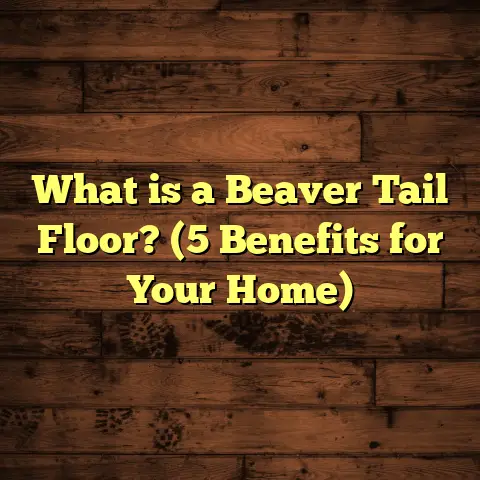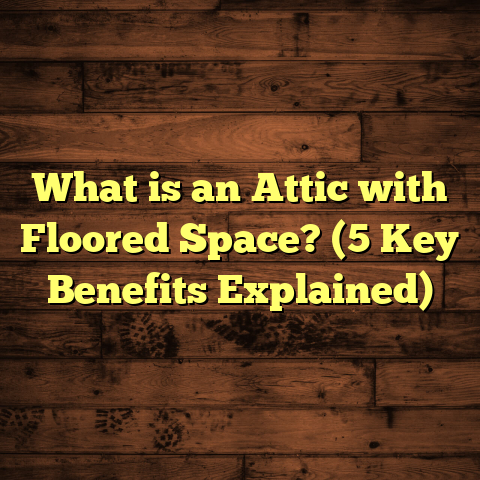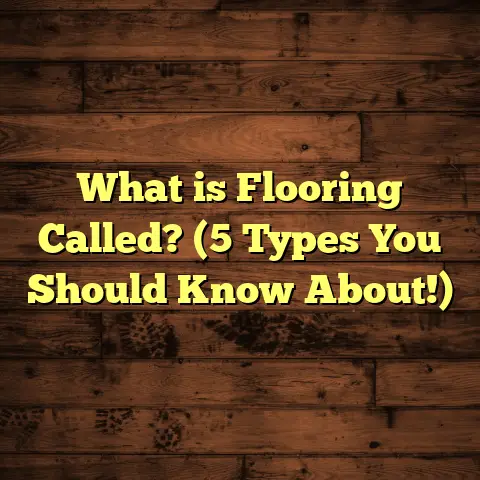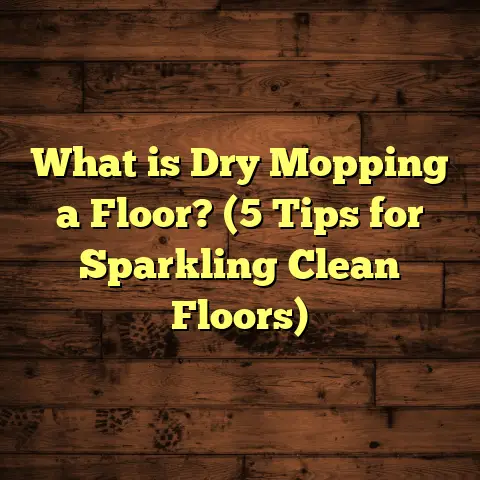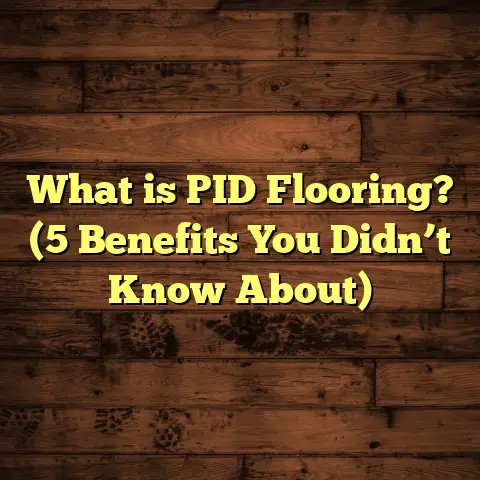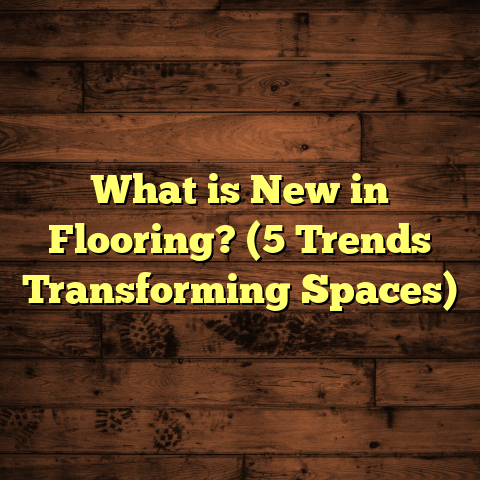What is LVT Flooring? (5 Reasons It’s Your Best Choice!)
Focusing on the Future of Flooring: Why LVT Is Worth Your Attention
When I think about flooring options for homes or commercial spaces, my mind always drifts toward what the future might bring. Flooring isn’t just about what looks good today—it’s about how it stands up over time, how easy it is to care for, and how well it fits your lifestyle years from now. Over the course of my career as a flooring contractor, I’ve seen countless materials come and go, with trends rising and fading. But one type of flooring that keeps impressing me—and keeps coming back into my recommendations—is LVT flooring.
I remember the first time I installed LVT in a client’s home. It was a small renovation project, and honestly, I wasn’t expecting it to be such a game-changer. But as time passed, I realized there was something unique about this flooring type. It combined style, durability, affordability, and ease of maintenance in a way that few other materials do. Since then, I’ve used LVT in residential homes, commercial spaces, even some high-traffic retail stores—and every time, it has proven itself.
So let me share with you my experience, insights, and some solid data about why LVT might just be the best flooring choice you’ll make. Whether you’re renovating your kitchen, upgrading your office, or building a new home, you’ll find something useful here.
What Is LVT Flooring?
LVT stands for Luxury Vinyl Tile. At its core, LVT is a type of vinyl flooring designed to mimic the look and feel of natural flooring materials like hardwood, stone, or ceramic tile—but with added benefits that traditional vinyl can’t quite match.
Unlike the thin, sheet vinyl you might be thinking of, LVT is made up of several layers:
- Wear Layer: This is the topmost layer that protects against scratches, stains, and dents.
- Design Layer: This layer contains high-definition images printed to replicate natural textures such as wood grain or stone patterns.
- Core Layer: Provides the core stability and thickness.
- Backing Layer: This gives the floor its resilience and helps with installation stability.
The beauty of LVT is that it manages to look incredibly realistic. Thanks to advances in printing technology, you can hardly tell the difference between an LVT plank and real hardwood flooring when you look closely. And it’s not just about looks—it’s about how the floor performs over time.
Here’s something many people don’t realize: according to the Freedonia Group’s 2023 report on vinyl flooring markets, LVT has seen an annual growth rate of around 6-7% worldwide over the last five years. This growth isn’t just hype; it reflects real demand driven by the product’s advantages.
How Is LVT Different from Other Vinyl?
You might wonder how LVT differs from traditional vinyl flooring or even laminate floors. Here’s a quick comparison based on my experience:
- Traditional Sheet Vinyl: Usually comes in large sheets with less realistic patterns and lower thickness. It tends to feel softer underfoot but doesn’t offer the same durability or design variety.
- Laminate Flooring: Mimics wood but is made from fiberboard with a photographic layer underneath a protective coating. Laminate can’t handle moisture well and often suffers from swelling or warping.
- LVT: Combines realistic visuals, water resistance, and durability with multiple installation options and comfort underfoot.
If you’re someone who has avoided vinyl because you thought it looked cheap or felt flimsy, I get it—I used to think that way too. But LVT changed my mind completely.
1. Durability That Keeps Up with Life
If you’ve ever installed hardwood floors or laminate in a busy household, you know how quickly they can show signs of wear. Kids running around with sneakers, pets scratching at doors, moving furniture—these all take a toll.
In my experience working with various clients—from families to business owners—durability is hands down one of the biggest deciding factors when choosing flooring. And here’s where LVT really shines.
What Makes LVT Durable?
The thick wear layer on LVT protects against scratches, dents, stains, and scuffs. Depending on the product grade:
- Residential-grade LVT typically has wear layers between 12 mil (0.3 mm) to 20 mil (0.5 mm).
- Commercial-grade LVT often features wear layers up to 30 mil (0.75 mm).
I worked on a project for a daycare center once—an environment where floors endure constant abuse from toys, spills, and heavy foot traffic daily. The owners chose a commercial-grade LVT product with a 28-mil wear layer. Two years in, the floor still looked fantastic.
Data on Durability
According to research by Armstrong Flooring (a major manufacturer), LVT flooring can last between 10 to 20 years depending on usage and maintenance. This compares favorably to laminate (usually 8-12 years) and engineered hardwood (10-15 years). Real hardwood can last decades but only if properly maintained—a big “if” in active households.
Real-Life Durability Stories
I remember one customer who owned a café. They wanted their new floor to withstand constant foot traffic plus occasional dropped dishes. We installed an LVT floor with a commercial wear layer and textured surface for slip resistance. After a year of service without any visible damage or fading, they told me they’d made the right choice.
If you want flooring that’s going to stand up to whatever life throws at it—kids playing soccer indoors or pets sliding across floors—LVT is worth serious consideration.
2. Water Resistance Means Worry-Free Spaces
One of the biggest headaches I hear from homeowners is worrying about water damage on floors. Hardwood floors are notoriously vulnerable to water spills or humidity changes—they can warp, swell, or stain easily.
LVT flips that script because it’s highly resistant to moisture.
How Water Resistance Works in LVT
Most LVT products have waterproof cores made from PVC vinyl combined with waterproof backing layers. This means spills don’t seep into the floorboard itself like they would with wood or laminate.
From what I’ve seen firsthand during installations in bathrooms and kitchens, this water resistance makes cleaning up accidents stress-free. You don’t have to panic over spilled wine at dinner parties or wet muddy footprints after rainy days.
Facts About Water Damage and Flooring
The National Wood Flooring Association has reported that water damage causes nearly 35% of flooring replacements in residential settings each year—a surprisingly high figure!
In contrast, homes with waterproof floors like LVT see far fewer replacements due to moisture issues.
Personal Experience With Water-Resistant Floors
I once installed LVT in a basement apartment where moisture was a big concern because of occasional flooding during heavy rains. The LVT held firm without swelling or warping even after months of damp weather.
For families with small children or seniors prone to spills or accidents—choosing water-resistant flooring like LVT can make everyday life easier.
3. Design Variety That Fits Every Taste
One thing that blew me away when I first started using LVT was how many design options were available. Want hardwood? You can get wide-plank oak or even exotic maple looks with beautiful textures. Prefer stone? Marble and slate patterns are available in stunning detail.
This means you don’t have to compromise on style just because you want durable and easy-care floors.
How Realistic Does LVT Look?
Thanks to cutting-edge printing technology called “digital imaging,” manufacturers produce ultra-realistic visuals on LVT that closely replicate natural materials—even down to knots in wood or grain patterns in stone.
In many cases, it’s difficult for guests to tell the difference unless they touch the floor closely.
Popular Styles I Recommend
I’ve installed several styles over the years:
- Rustic Wood-Look: Perfect for cozy cabins or farmhouse styles.
- Modern Gray Tones: Great for contemporary apartments or offices.
- Classic Marble Tile Patterns: Adds elegance to kitchens or bathrooms.
- Textured Slate: Ideal for commercial lobbies or mudrooms needing grip.
Data on Design Preferences
A survey by Houzz found that over 72% of homeowners wanted floors that matched their interior design vision without requiring excessive maintenance. LVT fits perfectly here because it delivers both aesthetics and practicality.
My Favorite Design Story
One couple wanted their living room floor to look like reclaimed wood but couldn’t afford expensive hardwood. We picked an LVT product with deep embossing and rustic color tones. They were amazed at how real it looked—and they loved how comfortable it was underfoot compared to normal tile.
4. Installation Flexibility Saves Time and Money
If there’s one thing I’ve learned from thousands of hours on job sites: installation time and cost matter big time.
Hardwood floors often require professional installation that can take days—sometimes weeks—with necessary acclimation periods and finishing work afterward.
LVT changes that dynamic because it offers several installation methods:
- Click-Lock Floating Floors: These snap together without glue or nails—perfect for DIYers.
- Glue-Down: Provides extra stability for commercial use.
- Loose Lay: Simply laid over smooth subfloors without adhesives—ideal for quick renovations.
Because of this flexibility, installation costs are often significantly lower than hardwood or ceramic tile.
My Installation Experience
I remember a kitchen remodel where the homeowner wanted new floors fast before a family gathering. We installed click-lock LVT over existing vinyl flooring in two days flat—no demolition needed.
That fast turnaround meant less disruption for them and lower labor costs overall.
Data on Installation Costs
According to HomeAdvisor’s 2024 estimates:
- Hardwood installation averages $6-$12 per square foot.
- Laminate installation runs $3-$8 per square foot.
- LVT typically costs $2-$7 per square foot installed depending on product grade and method.
So if budget or timing is tight, LVT often comes out ahead without sacrificing quality or look.
5. Easy Maintenance for Busy Lives
Let’s be honest: most people don’t want floors that demand hours of upkeep every week. Between work, family, social commitments—it’s nice when floors simply stay clean without extra fuss.
LVT fits perfectly into busy lifestyles because maintenance is straightforward:
- Regular sweeping or vacuuming removes dust.
- Occasional damp mopping with gentle cleaners keeps surfaces fresh.
- No polishing or refinishing needed like hardwood.
- Stains wipe off easily due to protective wear layers.
What About Longevity of Appearance?
Good-quality LVT resists fading from sunlight better than natural hardwood because of UV-protective coatings applied during manufacturing. So your floors won’t dull over time if exposed to windows.
I had one client who frequently hosted outdoor parties spilling drinks indoors; their floors stayed virtually spotless thanks to stain-resistant wear layers.
Personal Maintenance Tips
I always tell clients:
- Use felt pads under furniture legs.
- Avoid abrasive cleaners or scrub brushes.
- Clean spills quickly for best results (though not mandatory because LVT is forgiving).
With simple care like this, your floors will keep looking great year after year without extra expense.
Digging Deeper: Additional Benefits You Might Not Expect
While those five reasons cover most bases, there are other perks worth mentioning based on my hands-on experience:
Sound Absorption
Compared to harder surfaces like tile or stone, LVT provides better sound dampening which reduces noise transmission between rooms—a bonus for apartments or multi-level homes.
Comfort Underfoot
Because of its layered construction and soft vinyl core, LVT feels warmer and softer underfoot compared to ceramic tiles or stone—even providing some cushioning during long periods of standing.
Allergy-Friendly Flooring
Unlike carpets that trap dust mites and allergens, smooth-surfaced floors like LVT are easier to keep allergen-free—great for families with allergy sufferers.
Case Study: How LVT Transformed a Family Home
Let me share an example that perfectly illustrates why I’m such a fan of LVT flooring.
A couple with two energetic toddlers wanted new flooring throughout their main living spaces but were worried about durability and spills ruining hardwood floors they initially loved. Their old carpet was stained and worn out from years of use.
After discussing options together—and factoring in their budget—they chose a high-end wood-look LVT featuring:
- A 20-mil wear layer
- Waterproof core
- Textured finish mimicking natural oak grain
Six months later during a follow-up visit:
- No visible scratches despite toddler toys everywhere
- No swelling or damage from frequent juice spills
- Floors still looked clean and felt warm underfoot
- Cleaning was quick and easy for the busy parents
They said: “It looks amazing and handles everything our kids throw at it.”
That kind of real-world success story is why I keep recommending LVT again and again for families who want style plus practicality.
Common Questions About LVT Flooring
Here are some questions I often get asked:
Does LVT Feel Like Real Wood?
Yes! High-quality LVT uses embossed textures that mimic wood grain patterns closely enough that many guests don’t realize it’s vinyl until they touch it.
Can I Install LVT Myself?
Absolutely! Click-lock varieties are designed for DIY installation with minimal tools needed. Just make sure your subfloor is clean, flat, and dry before starting.
Is It Environmentally Friendly?
While vinyl is petroleum-based, many manufacturers now produce low-VOC (volatile organic compounds) products meeting strict indoor air quality standards. Also, some brands offer recycling programs for leftover materials.
How Much Does It Cost?
Depending on quality and brand:
- Basic residential-grade starts around $2-$3 per square foot.
- Premium designs range $5-$7 per square foot installed. This makes it competitive compared to mid-range hardwood or tile options.
Wrapping Up My Thoughts on LVT Flooring
After working closely with various flooring materials over many years—and hearing clients’ feedback—I feel confident saying that Luxury Vinyl Tile stands out as one of the smartest choices available right now.
It blends durability with style flexibility while offering ease of installation and maintenance—all important factors for modern living spaces where time and budgets matter.
If you value practicality but don’t want to sacrifice beauty or comfort—LVT deserves your serious attention.
Are you considering new flooring? Have you tried LVT before? I’d love to hear your stories or questions about this versatile flooring option!
If you want me to include specific product recommendations or regional pricing info based on your location or project type next, just ask!
